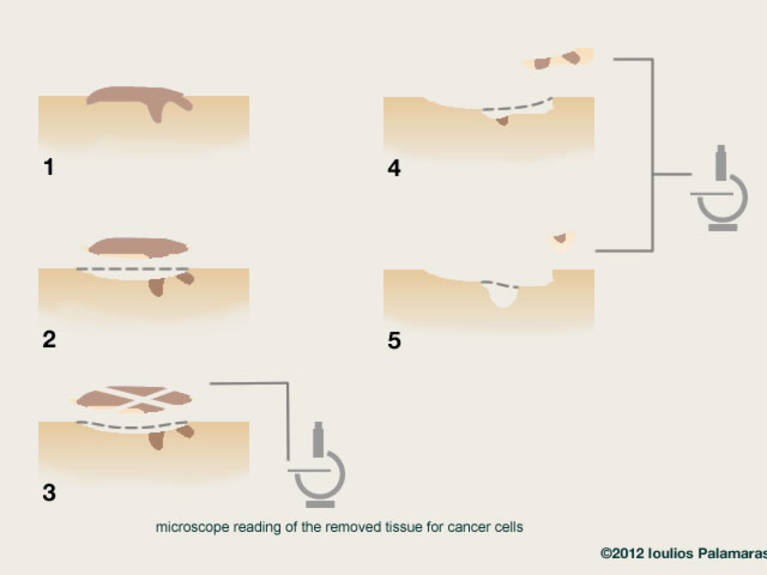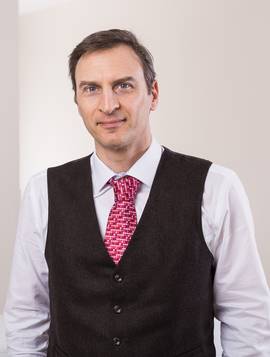Mohs Surgery Information
This is a specialised form of surgery to remove certain skin cancers (tumours) and it is called Mohs’ surgery after the doctor who developed it.
Dr Palamaras removes the visible portion of your tumour and then removes further tissue that may contain cancer cells, one layer at a time. This tissue is examined under a microscope while you are still in the dermatology unit. If it contains cancer cells, another layer of tissue is removed and examined. This is repeated until all the cancer cells have been removed, which may last several hours.
Why should I have micrographic surgery?
Other types of surgery for skin tumours rely on the surgeon being able to see the extent of the cancer. This can sometimes lead to a large wound and scar if too much healthy tissue is removed. It could also lead to too little tissue being removed and the cancer returning. Micrographic surgery maximises the chances of your tumour being completed excised (removed) while minimising the amount of surrounding normal skin that needs to be taken away.
Are there any other alternatives?
Dr Palamaras has recommended that this is the most appropriate treatment for you. Any alternatives will have been discussed at your consultation.
If your skin cancer is not treated, it will continue to grow and you may need more aggressive treatment in the future.
How can I prepare for my surgery?
Please do not wear any make up or jewellery on or near the site of your surgery. You may want to bring a packed lunch with you on the day of the surgery, as you may be here for several hours.
Dr Palamaras strongly suggests that you bring a friend or family member with you. Dr Palamaras strongly recommends that you do not travel home by public transport and you should not, under any circumstances, drive yourself on the day of your surgery.
Asking for your consent
Dr Palamaras always wants to involve you in all the decisions about your care and treatment. If you decide to go ahead with this surgery, you will be asked to sign a consent form. This confirms that you agree to have the procedure and understand what it involves.
What happens during Mohs’ surgery?
There are several stages to Mohs’ surgery. First, Dr Palamaras will inject the area where your tumour is, with a local anaesthetic. This numbs the area, so you will not feel any pain during surgery and will remain awake. If you are particularly anxious, Dr Palamaras can give you a mild sedative to help you relax. Please discuss this with Dr Palamaras. He may also use anaesthetic eye drops if the tumour is near your eye.
Once the anaesthetic has taken effect, the visible (also called the clinically evident) part of the tumour is removed, along with a small margin of normal skin tissue. This tissue is taken to a laboratory where Dr Palamaras will be able to look at it under a microscope to check for cancer cells. This takes about 40-60 minutes, so a temporary dressing is applied to your wound and you are asked to sit in the waiting area.
If cancer cells are present in this tissue, you will be brought back into the theatre and more tissue will be taken away and examined under the microscope. This will be repeated until all the tumour cells have been removed.

The local anaesthetic lasts for about two hours and can be ‘topped up’ if your surgery takes longer than this. Because of the nature of this procedure, Dr Palamaras is unable to tell you exactly how long your surgery will last.
What happens after the procedure?
Once all the tumour cells have been removed, there are several options for repairing your resulting wound, depending on your individual circumstances. These will be discussed with you in more detail before your surgery. Your wound may be:
closed by Dr Palamaras and his team who performed the micrographic surgery immediately after the tumour has been removed,
dressed and then repaired by a plastic surgeon,
left to heal normally,
repaired at another hospital. In this case, Dr Palamaras will renew your dressing before you travel to your referring hospital. You will be told how to look after your wound by the team that repairs your wound.
What are the risks?
Dr Palamaras will explain the potential risks for this type of surgery with you in more detail, but complications include:
Bleeding: at the site of the tumour.
Pain: The local anaesthetic should last until you return home. If you need to, you can buy aspirin-free pain relief (such as paracetamol) from a chemist without a prescription. Always check that the painkillers will not react with any other mediation you are taking and follow the instructions on the packet. The doctor or nurse caring for you can give you more advice.
Nerve damage: Although your surgeon will try to avoid this, nerves can occasionally be damaged during surgery, leading to a numb area of skin. This is usually temporary. Infection at the wound site: You will be given instructions on how to care for your wound to minimise this risk.
Scarring: You will have a scar after the surgery, although Dr Palamaras uses plastic surgery closure techniques to minimise this. Scars fade over time.
What do I need to do after I go home?
Before you leave the clinic/hospital, please make sure you have been given information about how to look after your wound at home.
You will probably need to rest after the surgery for about 48 hours. If you work, we recommend that you take at least two days off after the surgery. We will give you more advice on the day of your surgery.
Will I have a follow-up appointment?
You will have a follow-up appointment with the team that repaired your wound.
Dr Palamaras will usually see you one week after your surgery to check that your skin is healing well and remove any stitches you may have. If there are any changes to this, he will advise you on the day of your surgery. If another team repairs your wound they will give you a follow-up appointment.
Dr Palamaras usually see you again approximately three months after your wound has healed for a final check up.
